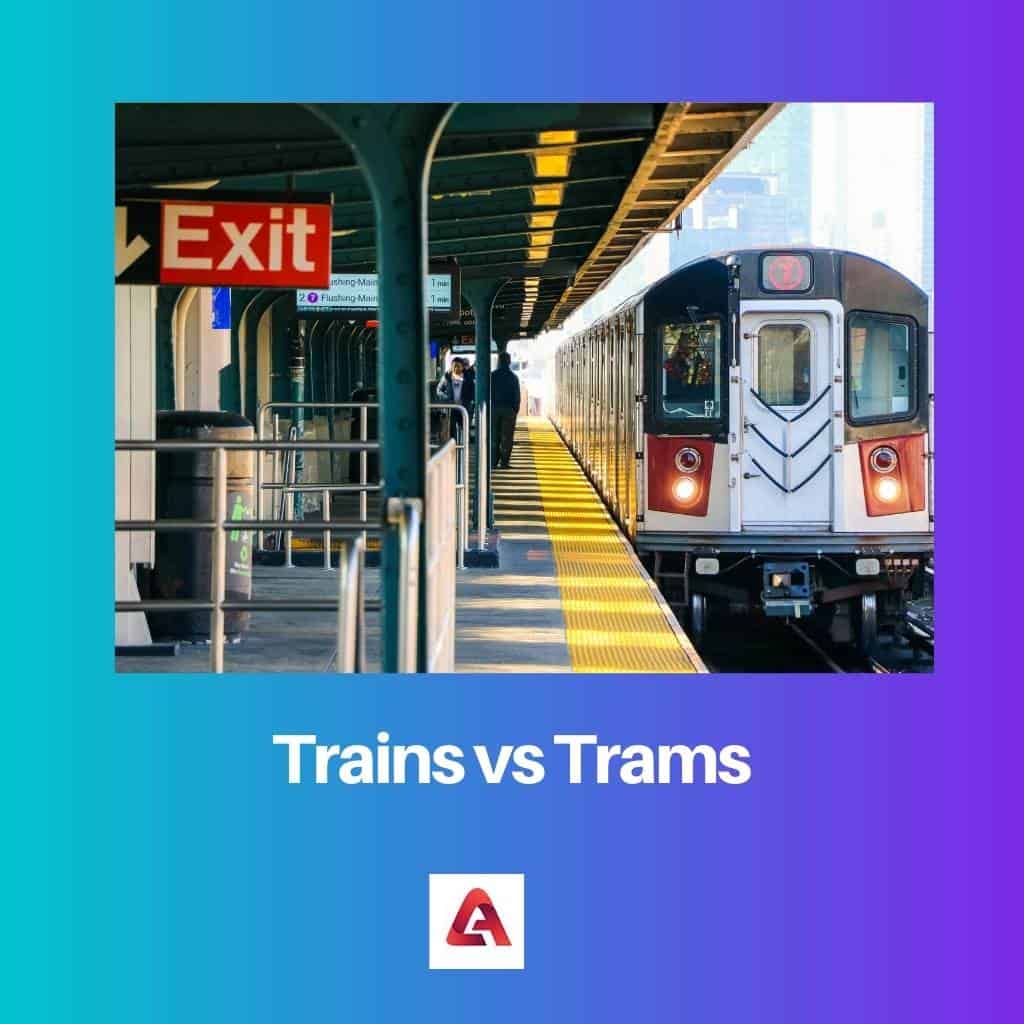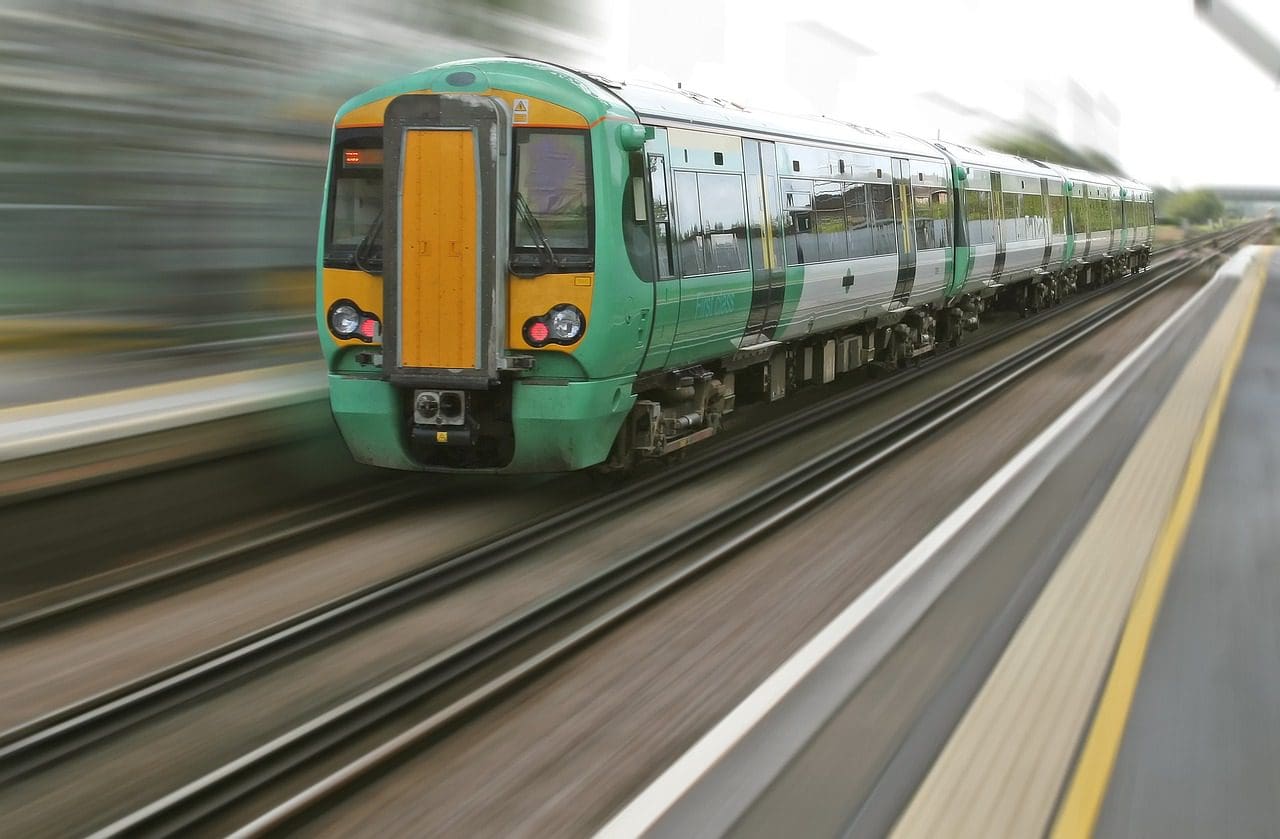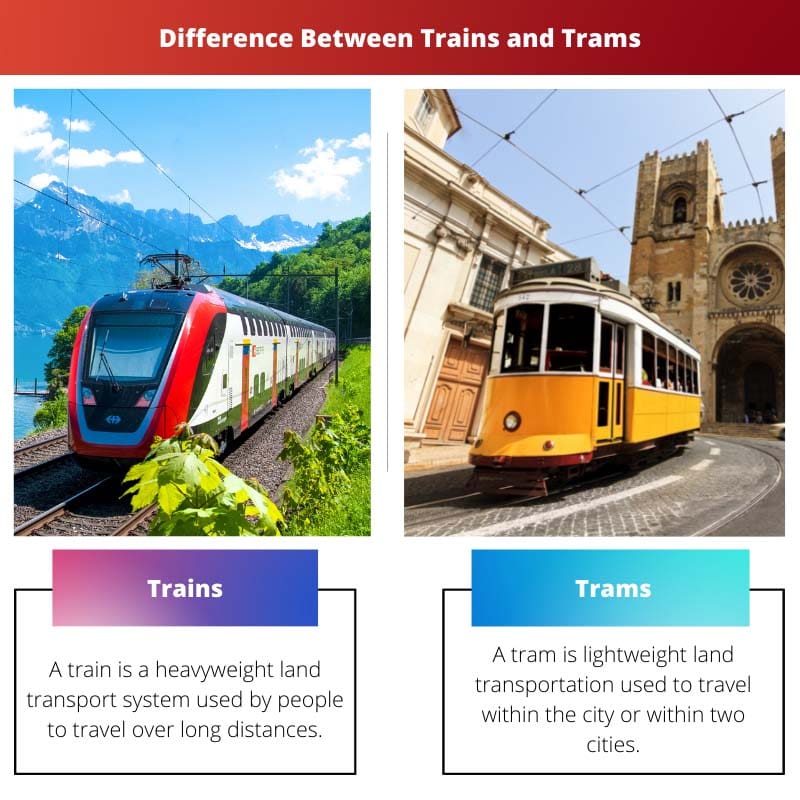Trains operate on dedicated tracks, facilitating higher speeds and longer distances, ideal for intercity and regional travel. Trams, on the other hand, navigate city streets, offering frequent stops and shorter distances, enhancing urban mobility and accessibility within densely populated areas.
Key Takeaways
- Trains are long and heavy vehicles that run on tracks and are primarily used for long-distance travel and transportation of goods, while trams are shorter and lighter vehicles that run on tracks and are used for short-distance travel within a city.
- Trains can reach high speeds and travel long distances, while trams have a limited speed and travel shorter distances.
- Trains require dedicated tracks and stations, while trams can share the road with other vehicles and have stops along the way.
Trains vs Trams
The difference between trains and trams is that trains are heavyweight long-distance transport systems that have more coaches attached to a coal-driven or steam-driven engine to increase their passenger capacity, it runs on iron tracks which are termed railways and are laid some inches above the ground, on the other hand, trams are lightweight short distance transport system with only a few coaches and carriages attached to an electronic or diesel driven engines, they run on ground level lightweight tracks.

Comparison Table
| Feature | Trains | Trams |
|---|---|---|
| Purpose | Long-distance travel, transporting large volumes of passengers and freight | Short-distance travel within urban areas, primarily transporting passengers |
| Tracks | Dedicated, elevated or ground-level tracks, separated from roads | Shared roads with other vehicles or dedicated tram tracks within the street |
| Speed | Higher speeds (50-200+ km/h) | Lower speeds (20-40 km/h) |
| Capacity | Higher passenger capacity (multiple carriages) | Lower passenger capacity (single or few carriages) |
| Frequency | Less frequent, scheduled departures | More frequent, following a set schedule |
| Stops | Fewer stops, at designated stations | More frequent stops, closer to destinations |
| Boarding/Alighting | Requires platforms for safe boarding/alighting | Often uses level boarding directly from the street |
| Power Source | Diesel, electric, or a combination | Primarily electric, drawing power from overhead lines |
| Cost | Generally more expensive to operate and maintain | Generally less expensive to operate and maintain |
| Impact on environment | Can have higher emissions depending on fuel source | Generally considered more environmentally friendly |
What is a Train?
Trains are a form of rail transport that operate on dedicated tracks, offering efficient and reliable transportation for passengers and freight. These tracks can span vast distances, connecting cities, regions, and even countries, with specialized infrastructure such as stations, signaling systems, and maintenance facilities.
Characteristics and Advantages
- High Speeds and Long Distances: Trains are designed for speed and efficiency, reaching high velocities on long stretches of track. This makes them ideal for intercity and long-distance travel, where they can outpace other modes of transportation like cars or buses.
- Capacity and Comfort: Trains can accommodate a large number of passengers and goods, offering spacious seating arrangements and amenities such as dining cars and restrooms. This capacity makes them suitable for mass transit over extended distances.
- Environmental Benefits: Compared to individual cars or trucks, trains are more energy-efficient and produce fewer emissions per passenger or ton of freight transported. This makes them a greener option for long-haul journeys, contributing to sustainability efforts and reducing the carbon footprint of transportation networks.
- Reliability and Safety: Trains are known for their reliability, adhering to fixed schedules and operating under stringent safety regulations. With dedicated tracks and advanced signaling systems, the risk of accidents is minimized, ensuring a safe journey for passengers and cargo alike.

What is a Tram?
Trams, also known as streetcars or trolleys, are light rail vehicles that operate primarily within urban areas, navigating city streets alongside other traffic. Unlike trains, trams do not have dedicated tracks and instead share road space with cars, cyclists, and pedestrians. They feature overhead wires for power supply and make use of designated tram stops located along their routes.
Characteristics and Advantages
- Local Connectivity and Accessibility: Trams serve as vital links in urban transportation networks, providing convenient and accessible connections between residential areas, business districts, and major transportation hubs. Their frequent stops and coverage of densely populated areas make them an integral part of urban mobility solutions, facilitating last-mile connectivity and reducing reliance on private vehicles.
- Flexibility and Integration: Tram systems are adaptable to the layout of urban environments, able to navigate narrow streets and negotiate tight turns. This flexibility allows cities to integrate tram lines seamlessly into existing infrastructure, enhancing overall transportation efficiency while minimizing disruption to local communities.
- Environmental Benefits: Trams are inherently eco-friendly modes of transportation, running on electricity and producing zero emissions at the point of use. As cities seek to reduce air pollution and combat climate change, tram systems offer a sustainable alternative to traditional bus fleets or private cars, contributing to cleaner and healthier urban environments.
- Historical and Cultural Significance: Trams hold a special place in the cultural heritage of cities around the world, symbolizing a bygone era of public transportation while remaining relevant in modern urban landscapes. Their nostalgic appeal, combined with their practical utility, makes them iconic features of many cities, attracting tourists and residents alike.

Main Differences Between Trains and Trams
- Infrastructure:
- Trains operate on dedicated tracks, while trams share roads with other vehicles and pedestrians.
- Speed and Distance:
- Trains are designed for high speeds and long-distance travel, ideal for intercity and regional journeys.
- Trams operate at lower speeds and cover shorter distances within urban areas, focusing on local mobility.
- Capacity and Frequency:
- Trains have higher passenger and freight capacity and operate on fixed schedules with fewer stops.
- Trams have lower capacity but offer more frequent stops, catering to short-distance travel needs within cities.
- Environment and Integration:
- Trains are energy-efficient for long-haul journeys and contribute to regional connectivity.
- Trams are environmentally friendly within urban settings and integrate seamlessly with city infrastructure, providing last-mile connectivity.





